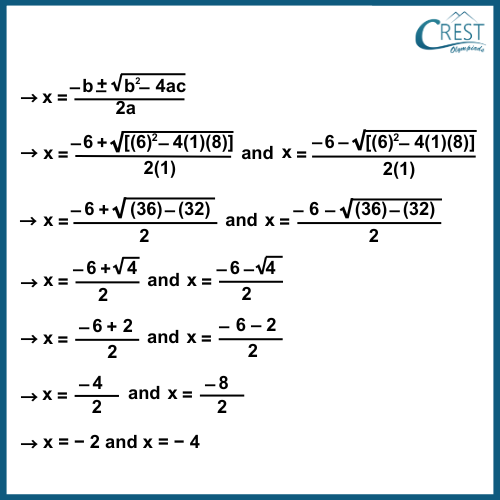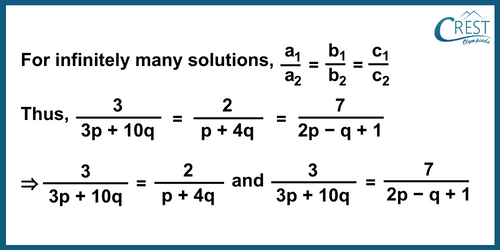Solved Questions on Quadratic and Linear Equations
1. What is the solution of the following pair of linear equations 5x + y = 10 and 10x − 7y = 50?
a) x = − 8⁄3 and y =
b) x = − 8⁄3 and y = −
c) x = 8⁄3 and y =
d) x = 8⁄3 and y = −
Answer: d) x = 8⁄3 and y = −
Explanation: We are given a pair of linear equations in two variables
5x + y = 10 … (1)
10x − 7y = 50 … (2)
Now, express the value of y in terms of x from the equation (1),
y = 10 − 5x … (3)
Now we substitute this value of y in Equation (2),
→ 10x − 7(10 − 5x) = 50
→ 10x − 70 + 35x = 50
→ 45x = 50 + 70
→ 45x = 120
→ x = 120/45
→ x = 8⁄3
Substitute this value of x = 8⁄3 in equation (3) to find the value of y.
→ y = 10 − 5()
→ y = 10 −
→ y =
→ y =
Thus, x = 8⁄3 and y = −10⁄3
2. If and are the roots of the equation x2 + 6x + 8 = 0, then which of the following equations has roots (α + β)2 and (α - β)2?
a) x2 − 144x + 40 = 0
b) x2 + 144x − 40 = 0
c) x2 + 40x − 144 = 0
d) x2 − 40x + 144 = 0
Answer: d) x2 − 40x + 144 = 0
Explanation: We are given x2 + 6x + 8 = 0
Here, a = 1, b = 6 and c = 8
We know that the roots of the quadratic equation are given by

Thus, α = − 2 and β = − 4 are the roots of the given quadratic equation.
Now, α + β = − 2 + (− 4) = − 2 − 4 = − 6
→ (α + β)2 = (- 6)2 = 36
Also, α − β = − 2 − (− 4) = − 2 + 4 = 2
→ (α - β)2 = (2)2 = 4
We know that a quadratic equation is obtained by the formula
x2 − (Sum of roots)x + Product of roots = 0
Thus, the quadratic equation with (α + β)2 and (α - β)2 as roots is:
→ x2 − [(α + β)2 + (α - β)2]x + [(α + β)2 × (α - β)2] = 0
→ x2 − [36 + 4]x + [36 × 4] = 0
→ x2 − 40x + 144 = 0
3. The ratio between a two-digit number and the sum of digits of that number is 5 : 2. If the digit in the unit place is 4 more than the digit in the tenth place, then what is the number?
a) 25
b) 18
c) 15
d) 38
Answer: c) 15
Explanation: Let the digit in the tenth place be a and the digit in the unit place be b.
Hence, the number is 10a + b.
We are given that the ratio between a two-digit number and the sum of digits of that number is 5 : 2.
→ =
→ 2(10a + b) = 5(a + b)
→ 20a + 2b = 5a + 5b
→ 20a − 5a = 5b − 2b
→ 15a = 3b
→ b =
→ b = 5a … (1)
We are also given that the digit in the unit place is 4 more than the digit in the tenth place.
→ b = a + 4 … (2)
Now, substitute the value of b = 5a in equation (2),
→ 5a = a + 4
→ 5a − a = 4
→ 4a = 4
→ a =
→ a = 1
Putting the value of a in equation (1) to find the value of b,
→ b = 5(1)
→ b = 5
Thus, the required number = 10a + b = 10(1) + 5 = 15
4. For which values of p and q, will the following pair of linear equations
3x + 2y = 7 and (3p + 10q)x + (p + 4q)y = 2p − q + 1 have infinitely many solutions?
a) p = - 8/33 and q = 1/11
b) p = - 8/11 and q = 1/11
c) p = 8/33 and q = - 1/11
d) p = 8/11 and q = - 1/11
Answer: a) p = - 8/33 and q = 1/11
Explanation: We are given the pair of linear equations
3x + 2y = 7
(3p +10q)x + (p + 4q)y = 2p − q + 1
Here, a1 = 3, a2 = 3p + 10q, b1 = 2, b2 = p + 4q, c1 = 7 and c2 = 2p − q + 1

First solving,
() = ()
→ 3(p + 4q) = 2(3p + 10q)
→ 3p + 12q = 6p + 20q
→ 3p − 6p = 20q − 12q
→ − 3p = 8q
→ p = -8⁄3 q … (1)
Now solving,
() = ()
→ 3 (2p − q + 1) = 7(3p + 10q)
→ 6p − 3q + 3 = 21p + 70q
→ 6p − 21p + 3 = 70q + 3q
→ − 15p + 3 = 73q … (2)
Substituting the value of p in equation (2)
→ − 15(-8⁄3 q) + 3 = 73q
→ − 5(− 8q) + 3 = 73q
→ 40q + 3 = 73q
→ 40q − 73q = − 3
→ − 33q = − 3
→ q = -3⁄-33
→ q = 1⁄11
Now put the value of q in equation (1) to find the value of p
→ p = -8⁄3 q
→ p = -8⁄3 (1⁄11)
→ p = -8⁄33
Hence, p = -8⁄33 and q = 1⁄11.
5. What is the value of ‘p’ if the product of roots of the given quadratic equation (p + 7)x2 − (2p − 11)x + (3p − 4) = 0 is 13⁄5?
a) 45.5
b) 55.5
c) 65.5
d) 75.5
Answer: b) 55.5
Explanation: We are given the quadratic equation (p + 7)x2 − (2p − 11)x + (3p − 4) = 0
Here a = p + 7, b = − (2p − 11) and c = 3p − 4
We know that the product of roots of a quadratic equation = c⁄a
Product of the roots the given quadratic equation = 13⁄5
→ () = 13⁄5
→ 13 × (p + 7) = 5 × (3p − 4)
→ 13p + 91 = 15p − 20
→ 91 + 20 = 15p − 13p
→ 111 = 2p
→ p = 111⁄2
→p = 55.5



